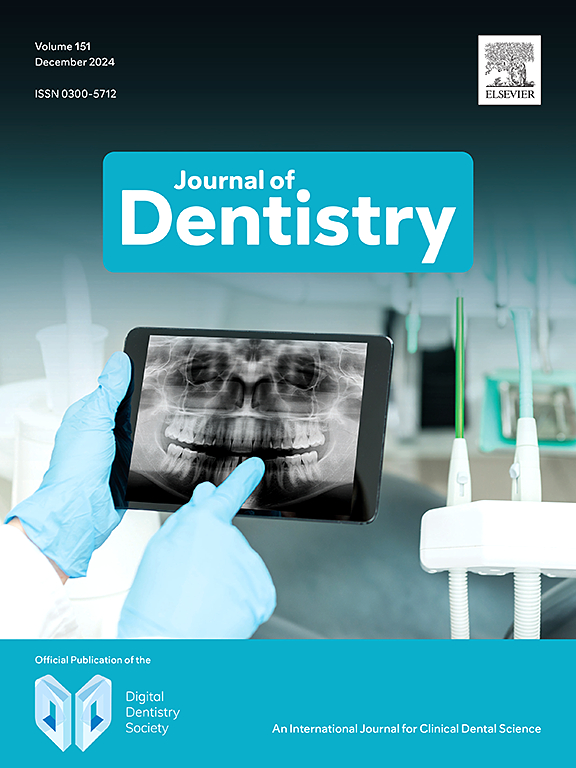Accuracy of detection methods for secondary caries around direct restorations: A systematic review and meta-analysis
IF 4.8
2区 医学
Q1 DENTISTRY, ORAL SURGERY & MEDICINE
引用次数: 0
Abstract
Objective
To evaluate and compare the accuracy of detection methods for the diagnosis of secondary caries around direct restorations in posterior teeth.
Data
Accuracy parameters including sensitivity, specificity, diagnostic odds ratio (DOR), area under curve (AUC), and partial AUC (pAUC) are generated from studies assessing the accuracy of detection methods for secondary caries.
Sources
Publications from PubMed, Web of Science, Scopus, Medline, EMBASE and Cochrane Library databases.
Study selection/results
This review included 25 studies evaluating visual examination (V(laboratory); n = 9 & V(clinical); n = 2), tactile examination (T; n = 3), intra-oral radiography (IR; n = 14), cone-beam computed tomography (CBCT; n = 4), quantitative light-induced fluorescence (QLF; n = 4), laser fluorescence (LF; n = 8) and digital imaging fiber-optic transillumination (DIFOTI; n = 1). The pooled sensitivity [95 % Confidence Interval, CI] and specificity [95 % CI] of detection methods for secondary caries were 0.60[0.45–0.73] and 0.67[0.53–0.78] for V(laboratory); 0.82[0.23–0.99] and 0.77[0.15–0.98] for V(clinical); 0.31[0.25–0.39] and 0.95[0.78–0.99] for T; 0.59[0.52–0.66] and 0.82[0.75–0.88] for IR; 0.61[0.48–0.73] and 0.82[0.64–0.92] for CBCT; 0.71[0.64–0.78] and 0.51[0.40–0.62] for QLF; 0.57[0.43–0.71] and 0.81[0.76–0.85] for LF; and 0.63[0.47–0.76] and 0.95[0.90–0.98] for DIFOTI. DOR values [95 % CI] of the secondary caries detection methods were V(laboratory)-2.88[2.18–3.80]; V(clinical)-16.66[3.84–72.28]; T-6.36[1.12–36.28]; IR-6.55[3.44–12.46]; CBCT-6.18[1.42–26.91]; QLF-2.25[1.39–3.63]; LF-4.86[2.40–9.82]; and DIFOTI-30.00[11.94–75.36], respectively. Respective AUC (pAUC) were V-0.645(0.535); T-0.379(0.315); IR-0.767(0.693); CBCT-0.887(0.820); QLF-0.581(0.633) and LF-0.828(0.590). AUC values were not available for DIFOTI and V(clinical).
Conclusions
Among the seven types of detection method for secondary caries diagnosis, none of the detection methods demonstrate satisfactory accuracy in detecting secondary caries around direct restorations in posterior teeth.
Clinical significance
This systematic review provides insights for the clinician and researcher in selecting the clinical detection method for secondary caries diagnosis and facilitates clinical decision making.
直接修复体周围继发性龋齿检测方法的准确性:系统回顾和荟萃分析。
目的:评价和比较几种检测方法诊断后牙直接修复体周围继发龋的准确性。数据:准确性参数包括敏感性、特异性、诊断优势比(DOR)、曲线下面积(AUC)和部分AUC (pAUC),这些参数来自评估继发性龋齿检测方法准确性的研究。资料来源:PubMed, Web of Science, Scopus, Medline, EMBASE和Cochrane图书馆数据库的出版物。研究选择/结果:本综述包括25项评估视力检查的研究(V;n=9),触觉检查(T;n=3),口腔内x线摄影(IR;n=14),锥束计算机断层扫描(CBCT;n=4),定量光诱导荧光(QLF;n=4)、激光荧光(LF;n=8)和数字成像光纤透照(DIFOTI;n=1),临床视觉检查(V(临床);n = 2)。继发性龋齿实验室检测方法的总灵敏度[95%置信区间,CI]和特异性[95% CI]分别为0.60[0.45-0.73]和0.67[0.53-0.78];T为0.31[0.25-0.39]和0.95[0.78-0.99];IR为0.59[0.52-0.66]和0.82[0.75-0.88];CBCT为0.61[0.48-0.73]和0.82[0.64-0.92];QLF为0.71[0.64-0.78]和0.51[0.40-0.62];LF为0.57[0.43-0.71]和0.81[0.76-0.85];DIFOTI为0.63[0.47-0.76]和0.95[0.90-0.98];V(临床)分别为0.82[0.23-0.99]和0.77[0.15-0.98]。继发性龋病检测方法的DOR值[95% CI]为V-2.88[2.18-3.80];t - 6.36 (1.12 - -36.28);ir - 6.55 (3.44 - -12.46);cbct - 6.18 (1.42 - -26.91);qlf - 2.25 (1.39 - -3.63);低频- 4.86 (2.40 - -9.82);difoti - 30.00 (11.94 - -75.36);V(临床)-16.66(3.84 - -72.28),分别。AUC分别为V-0.645(0.535);t - 0.379 (0.315);ir - 0.767 (0.693);cbct - 0.887 (0.820);QLF-0.581(0.633)和LF-0.828(0.590)。DIFOTI和V(临床)的AUC值无法获得。结论:在7种诊断继发性龋病的检测方法中,没有一种检测方法对后牙直接修复体周围继发性龋病的准确性令人满意。临床意义:本系统综述为临床医生和研究人员选择继发性龋病的临床检测方法提供了参考,有助于临床决策。
本文章由计算机程序翻译,如有差异,请以英文原文为准。
求助全文
约1分钟内获得全文
求助全文
来源期刊

Journal of dentistry
医学-牙科与口腔外科
CiteScore
7.30
自引率
11.40%
发文量
349
审稿时长
35 days
期刊介绍:
The Journal of Dentistry has an open access mirror journal The Journal of Dentistry: X, sharing the same aims and scope, editorial team, submission system and rigorous peer review.
The Journal of Dentistry is the leading international dental journal within the field of Restorative Dentistry. Placing an emphasis on publishing novel and high-quality research papers, the Journal aims to influence the practice of dentistry at clinician, research, industry and policy-maker level on an international basis.
Topics covered include the management of dental disease, periodontology, endodontology, operative dentistry, fixed and removable prosthodontics, dental biomaterials science, long-term clinical trials including epidemiology and oral health, technology transfer of new scientific instrumentation or procedures, as well as clinically relevant oral biology and translational research.
The Journal of Dentistry will publish original scientific research papers including short communications. It is also interested in publishing review articles and leaders in themed areas which will be linked to new scientific research. Conference proceedings are also welcome and expressions of interest should be communicated to the Editor.
 求助内容:
求助内容: 应助结果提醒方式:
应助结果提醒方式:


